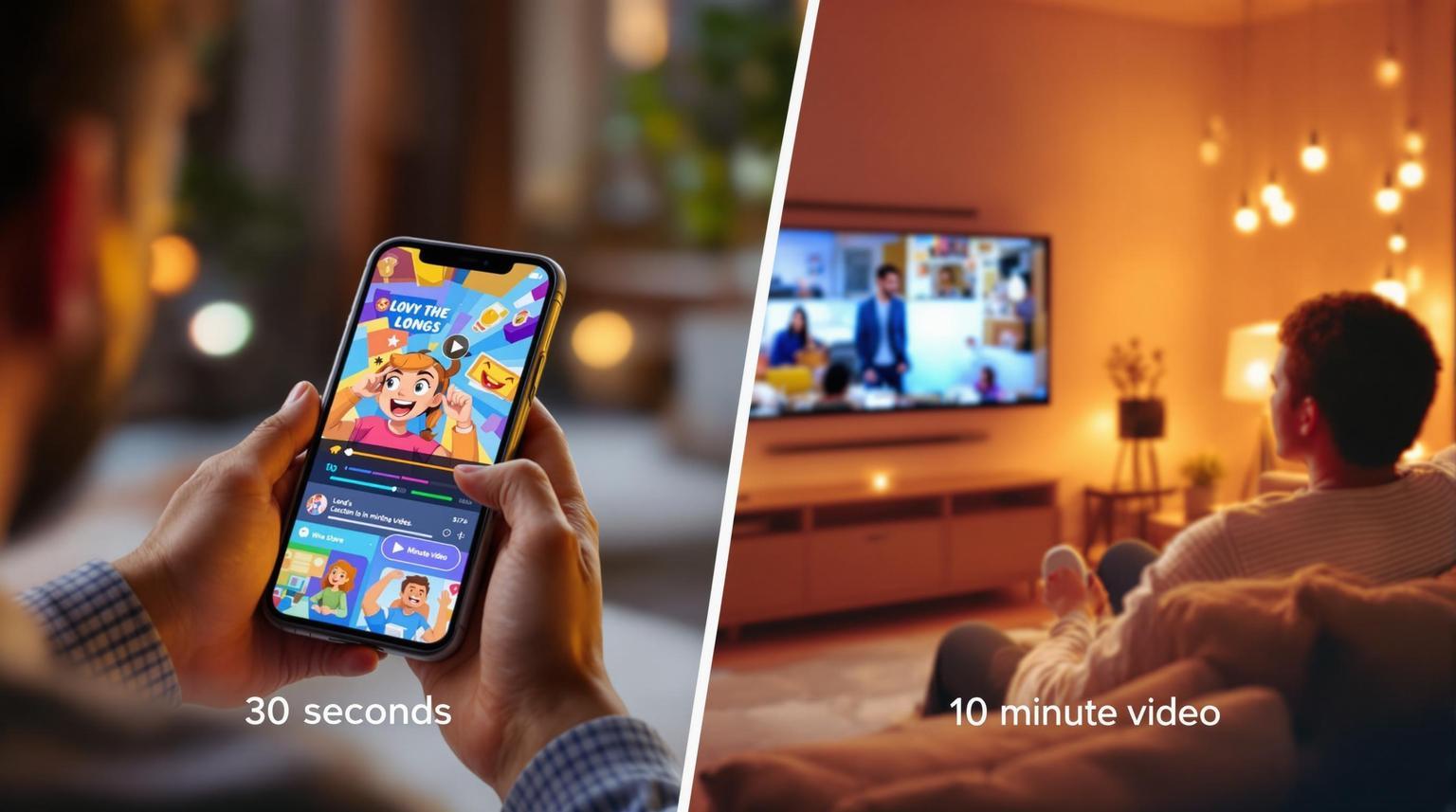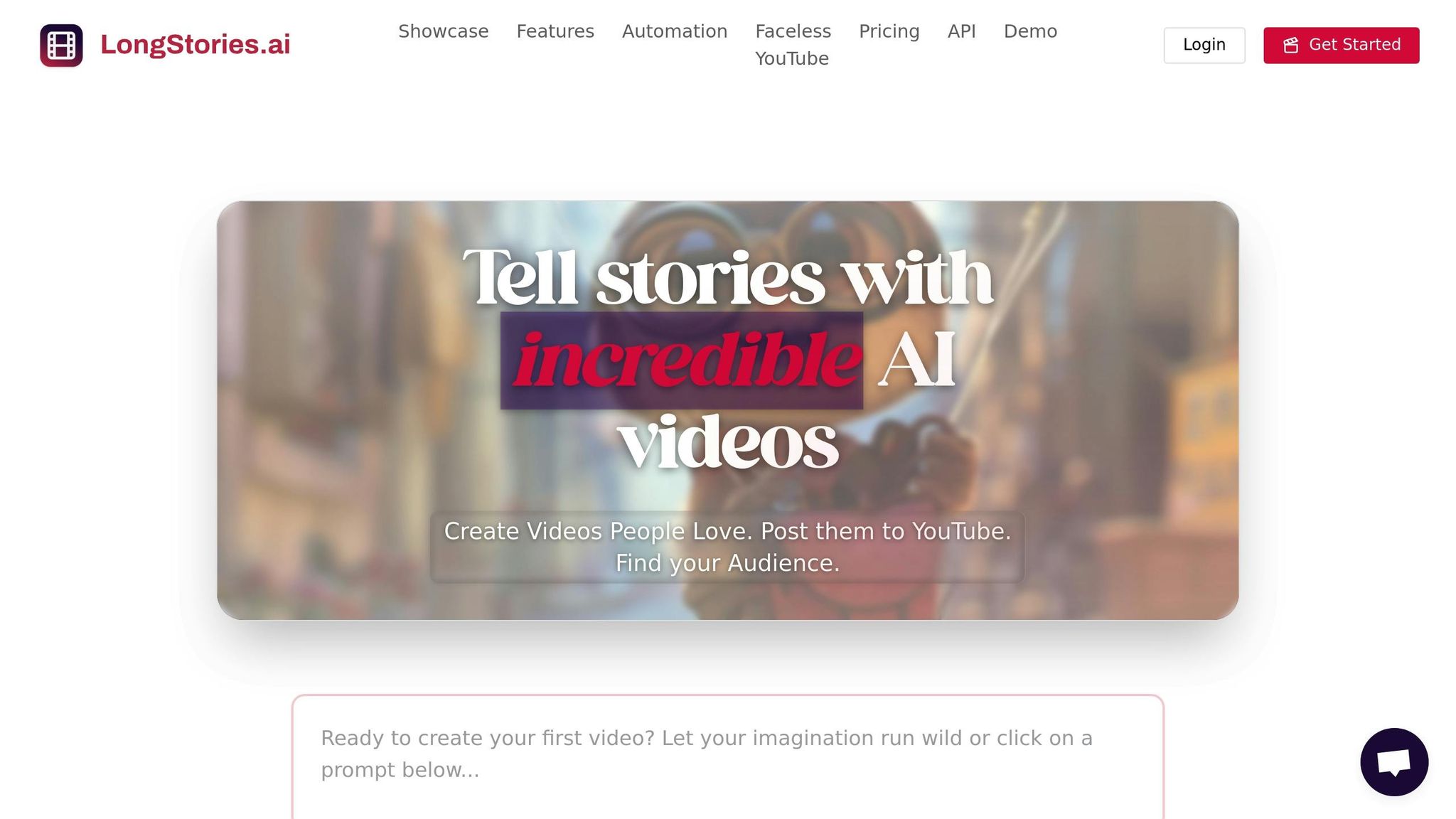
LongStories is constantly evolving as it finds its product-market fit. Features, pricing, and offerings are continuously being refined and updated. The information in this blog post reflects our understanding at the time of writing. Please always check LongStories.ai for the latest information about our products, features, and pricing, or contact us directly for the most current details.
Short vs. Long Videos: Which Drives More Engagement?
Video length plays a big role in engagement. Here's a quick breakdown:
- Short videos (under 3 minutes): Great for quick attention, viral sharing, and platforms like TikTok and Instagram Reels. Best for teasers, product demos, and fast tutorials. Key metrics: completion rates and replays.
- Long videos (10+ minutes): Ideal for storytelling, detailed tutorials, and educational content on platforms like YouTube. Best for in-depth insights and building connections. Key metrics: watch time and average view duration.
Quick Comparison:
| Aspect | Short Videos | Long Videos |
|---|---|---|
| Editing Style | Fast cuts, effects | Slower, detailed |
| Content Depth | Brief, to the point | In-depth, thorough |
| Best Platforms | TikTok, Reels, Shorts | YouTube, Vimeo |
| Viewer Time | 30 sec – 3 min | 10+ min |
| Audience | Younger audiences | Older audiences |
Pro Tip: Mix both formats for a balanced strategy - use short clips for social media and long videos for detailed content. AI tools like LongStories.ai simplify creating both types, saving time while keeping quality high.
Short-Form vs Long-Form Videos: Basic Concepts
Short-Form Video Basics
Short-form videos, usually under 3 minutes, dominate platforms like TikTok, Instagram Reels, and YouTube Shorts. These videos grab attention with quick edits, eye-catching transitions, and trending music to keep viewers hooked from start to finish.
Long-Form Video Basics
Long-form videos, typically over 10 minutes, thrive on platforms such as YouTube and Vimeo. They allow for more detailed storytelling, featuring structured introductions, multiple key points, and well-rounded conclusions. Tools like LongStories.ai make it easier to create structured content, especially for educational videos, documentaries, and tutorials.
These differences highlight the contrasting approaches in editing, content depth, and platform preferences.
Main Differences Between Formats
Here’s a quick comparison of the two formats:
| Aspect | Short-Form | Long-Form |
|---|---|---|
| Editing Style | Fast cuts and effects | Slower, more deliberate |
| Content Depth | Brief and to the point | Detailed and thorough |
| Platform Focus | TikTok, Reels, Shorts | YouTube, Vimeo |
| Viewer Time | 30 seconds – 3 minutes | 10+ minutes |
These characteristics shape how viewers engage with and retain content, offering insights into measuring video success on different platforms.
How to Measure Video Success
Watch Time Stats
Short and long videos show different patterns of viewer engagement. Short videos aim to keep viewers watching until the end, making completion rates a key metric. On the other hand, longer videos focus on keeping viewers engaged for as much of the video as possible, so metrics like average view duration become more important. These stats offer a clear view of how well your content holds attention.
Social Sharing Patterns
Social sharing adds another layer to understanding engagement. Short videos often spread quickly across platforms, leading to fast viral growth. In contrast, longer videos tend to spark in-depth conversations and more thoughtful comments, leading to extended engagement.
Platform-Specific Success Metrics
Each platform has its own way of measuring video performance. On YouTube, metrics like average view duration, thumbnail click-through rates, and comment activity are crucial. TikTok and Instagram Reels focus on rewatch rates and follower growth. Meanwhile, LinkedIn and Facebook prioritize metrics like audience retention among professionals and lead generation results.
To improve your video strategy, tools like LongStories.ai (https://longstories.ai) can provide detailed insights for both short and long video formats.
Engagement Analysis: Short vs Long Videos
Viewer Attention Patterns
The length of a video plays a big role in how audiences engage with it. Short videos are great for grabbing attention quickly, while longer videos allow for more detailed discussions. Viewers tend to follow these patterns, and platforms often boost content that matches how users interact with videos. Let’s look at how algorithms influence this dynamic.
How Algorithms Handle Video Length
Different platforms prioritize different metrics when it comes to video length. For example, YouTube focuses on total watch time, which gives an advantage to longer videos that keep people engaged for extended periods. On the other hand, platforms like TikTok reward videos with high completion rates and replays, making short, snappy content more likely to succeed.
Age Group Video Preferences
Age plays a key role in video preferences. Younger audiences generally lean toward quick, fast-paced content, while older viewers are more drawn to detailed, longer videos. Tools like LongStories.ai help creators produce both types efficiently, making it easier to tailor content for specific age groups and create a more focused strategy.
sbb-itb-94859ad
Maximize Engagement on Social Media: The Ultimate Guide to Video Length
When to Choose Each Format
Deciding on the right video format depends on your goals and how your audience engages with your content. Here's how to make the best choice.
Best Uses for Short Videos
Short videos work well for quick, impactful messages. They shine in situations like:
- Product demonstrations: Show off key features in seconds.
- Social media teasers: Build excitement for longer content.
- Tutorial snippets: Offer fast, easy-to-follow how-to guides.
- News updates: Share breaking stories as they happen.
- Brand awareness: Craft shareable moments that stick.
Keep the focus tight - one clear message delivers the best results.
Best Uses for Long Videos
Long videos are perfect when your content requires depth or storytelling. Use them for:
- Educational topics: Dive into detailed explanations.
- Documentary-style stories: Build emotional connections with your audience.
- Technical tutorials: Walk viewers through step-by-step instructions.
- Industry insights: Share case studies or detailed analysis.
AI tools like LongStories.ai can help maintain quality and consistency in longer videos. These tools remember your style and produce content that stays true to your vision.
Mixed Format Strategy
Blending short and long videos lets you use the strengths of both formats. Here's how to make it work:
- Content Repurposing: Start with a long video, then break it into shorter clips for social media. This keeps your messaging consistent while reaching more people.
- Platform-Specific Distribution: Tailor content for each platform:
- YouTube: Great for long-form videos.
- TikTok/Instagram: Perfect for short, engaging clips.
- LinkedIn: Combine quick insights with deeper analysis.
- Content Calendar Balance: Plan weekly long-form videos supported by daily short clips to keep your audience engaged.
Using AI tools can help you streamline scheduling and ensure your content feels cohesive across formats. Always choose the format that aligns with your goals and audience preferences.
AI Tools for Video Creation
AI technology has made it possible to create short and long videos faster than ever, cutting down production time while increasing viewer engagement.
LongStories.ai Features

LongStories.ai provides a range of tools designed to help users create videos of any length. Here's what stands out:
- Automated Script Generation: Write entire scripts with just one prompt.
- Smart Timing Control: AI adjusts pacing to suit different video lengths.
- Direct Platform Integration: Publish directly to YouTube with metadata optimized for better visibility.
"We are not another AI video generator. We create original stories that people actually want to watch, with the help of AI" – LongStories.ai
What used to take over 10 hours can now be done in just 5 minutes. But that's not all - AI tools also improve other parts of the video creation process.
AI for Better Video Results
AI tools can fine-tune video lengths based on engagement data, time key messages for maximum impact, and even enhance visuals by generating and refining images automatically. Plus, advanced analytics give creators insights to track performance and adjust strategies to keep audiences hooked, no matter the video length.
Wrapping It Up
The ideal video length depends on your goals and who you're trying to reach. Your choice should factor in your audience, the platform you're using, and what you want to achieve with the content.
Combining short and long videos often works best. Short videos grab attention quickly and can go viral, while longer ones allow for deeper storytelling and more detailed information. Think quick updates for short clips and in-depth narratives for longer videos.
AI tools make it easier to experiment with both formats. For instance, platforms like LongStories.ai help creators focus on storytelling while automating the technical side - whether it's for short social media clips or detailed tutorials on YouTube.
Here are some strategies to consider:
- Platform fit: Tailor video length to the preferences of each platform's audience.
- Know your audience: Use insights about your viewers to decide on the right duration.
- Mix it up: Combine short and long videos to meet different objectives.
Keep in mind that engagement metrics vary by platform. What's successful on TikTok might need tweaking for YouTube. The key is to deliver value, whether your video is a minute long or an hour. By understanding these dynamics and using the right tools, you can create content that resonates and keeps your audience engaged.
